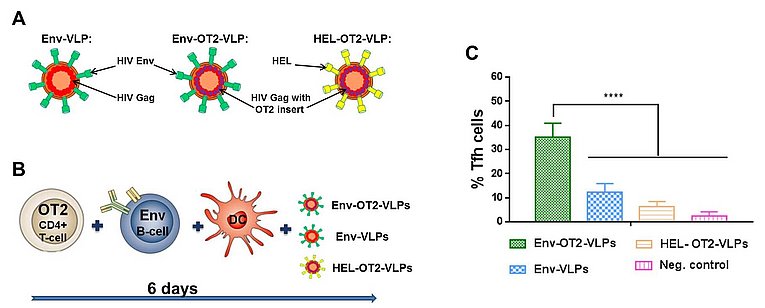Nanoparticle vaccines
Vaccination is the most effective method to achieve long-lasting protection against infectious diseases. Nanoparticles (NPs) are a promising platform for tailoring vaccine-induced immune responses. Currently, we investigate vaccine potency of modified biological and non-organic NPs in following projects:
Direct effects of HIV-1 derived lentiviral particles on activation and differentiation of naïve cognate T- and B-cells
Virus-like particles (VLPs) are a potent type of biological NPs. Safety and structural identity to prototype viruses turn them into an attractive component for vaccine formulations. “Natural” VLPs can be further genetically or chemically engineered to carry additional foreign antigens immunomodulatory and/or targeting molecules. Consequently, a number of VLP-based vaccines are in clinical trials; several are licensed.
In vitro, we revealed different aspects of cognate presentation of VLP-derived antigens between the dendritic, B- and CD4+ T-cells. Based on these observations, we established a co-culture system for generation of functionally active T follicular helper cells (Tfh) from naïve antigen-specific CD4+ T-cells (Figure 1). Simplicity, natural biological background, and minimal additional requirements make this co-culture system relevant for an initial screening of potential co-stimulators and adjuvants for VLP-based vaccines.
In vivo, we observed divergence of primary cognate B- and T-cell proliferative responses to subcutaneous and intravenous immunization with VLPs. VLPs induced comparable primary cognate T-cell proliferative responses in the draining lymph node and the spleen, irrespective of the delivery route. In contrast, after subcutaneous immunization the proliferative response of cognate B-cells was restricted to the draining lymph nodes, while intravenous VLP immunization primarily induced a B-cell proliferative response in the spleen.
Calcium phosphate nanoparticle-based vaccines
Different kinds of synthetic nanoparticles have been suggested for vaccination. However, there are some advantages to use calcium phosphate nanoparticles (CaP-NPs) for targeted delivery of antigens: CaP is a mineral component of mammalian bone and therefore not harmful to the body. CaP-NPs can be prepared in a multi-shell way in order to protect biomolecules inside and after cellular uptake release their cargo inside the cell upon lysosomal dissolution at lower pH. Their surfaces can be covalently functionalized with biomolecules to an effective cell targeting (Figure 2). In this collaborative project with Prof. Epple (Essen), we performed a side-by-side comparison of CaP-NPs functionalized with hen egg lysozyme (HEL) protein (CaP-HEL-NPs) on targeting, binding and internalization by cognate B-cells in vitro. CaP-HEL-NPs were preferentially bound and internalized by HEL-specific B-cells. They effectively cross-linked B-cell receptors and were 100-fold more efficient in the activation of B-cells than soluble HEL. In vivo, we explored different administration routes for the CaP-HEL-NPs and confirmed their ability to reach draining lymph nodes and deliver the protein in its native conformation to the B-cell areas. By using well-defined immunological adjuvants we increased the immunogenicity of CaP-HEL-NPs and were able to modulate the strength and quality of the systemic and the mucosal humoral immune responses. CaP-NPs functionalized with stabilized HIV-1 Env trimers and heterologous T-helper epitopes were able to recruit heterologous T-helper cells induced by a licensed vaccine and improved anti-Env antibody responses by intrastructural help. The results indicate that CaP-NPs represent a flexible platform to modulate humoral immune responses on demand that can be adapted to the particular needs of vaccines targeting various diseases.





